Contents
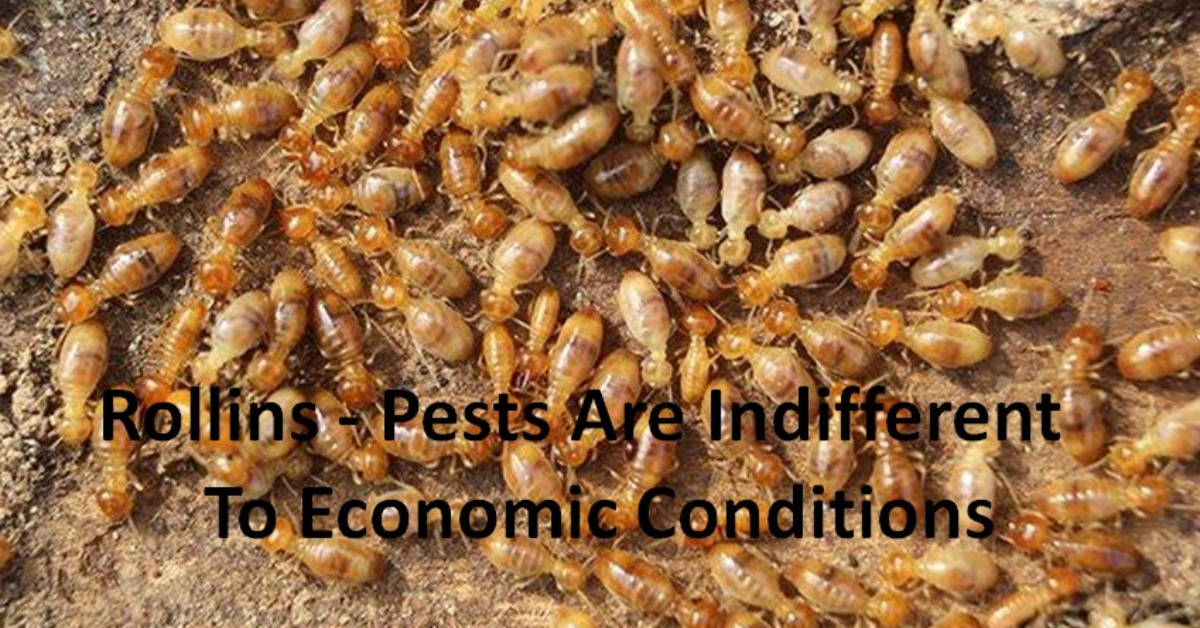
Fortunately for Rollins (ROL), pests are indifferent to economic conditions. It generates ~80% recurring revenue and boats 20+ years of revenue growth.
I last reviewed this holding in my November 19, 2022 post. With the release of FY2022 results following the February 15 market close, I revisit it to determine whether I should acquire additional shares.
Industry Overview
The pest control market size measured by revenue is ~$26.2B...and this is in the US alone! In comparison, this figure was ~$14.7B in 2013.
The market size in the US has grown ~7.0% per year on average between 2018 and 2023.
According to a report by Vantage Market Research, some global pest control market projections call for a market value of $33.79B by 2028.
One of the reasons this industry is steadily growing is that pests are indifferent to global economic conditions. Pests, however, do care about climate change because rising temperatures enable them to survive in areas that were previously too cold. Another reason for this industry's steady growth is the increasing awareness of the health risks posed by pests.
The low entry barriers are conducive to making this highly fragmented industry; the top 50 largest industry participants are estimated to control less than 15% of the total global market. It is estimated that there are ~31,567 pest control businesses in the US with the following states having the highest number of industry participants:
- Florida (4,629);
- California (3,906); and
- Texas (2,914)
Although the forecasted statistics are subject to debate, it is apparent the size of the industry is likely to continue to grow.
Rentokil Initial plc
Rentokil Initial plc (RTO) is a major industry participant. In October 2022, it completed its acquisition of Terminix Global Holdings, Inc. which was announced in December 2021. The annual revenue of the combined company exceeds $6B.
On June 27, 2022, RTO priced three bonds raising £1.6B to convert its bridge facility into long-term debt to cover the $1.3B cash element of the transaction consideration. The balance of the bonds together with a $0.7B 3-year loan facility were used to cover the refinancing of Terminix debt and transaction costs.
RTO's long-term issuer credit rating and senior unsecured facilities are assigned a BBB rating with a stable outlook by S&P Global; details of RTO's debt are accessible here. This rating is in the middle of the lower medium grade. It defines RTO as having an adequate capacity to meet its financial commitments. However, adverse economic conditions or changing circumstances are more likely to lead to a weakened capacity of the obligor to meet its financial commitments.
Following RTO's acquisition of Terminix, RTO's annual revenue is more than double that of ROL. ROL, however, is not burdened with debt.
Business Overview
ROL provides essential pest and wildlife control services and protection against termite damage, rodents and insects to more than 2 million residential and commercial customers from more than 800 company-owned and franchised locations in ~70 countries. It might not be a company that is on the 'cutting edge of technology'. However, ask anyone who has a termite, rodent or insect infestation and they will tell you that controlling or ridding themselves of these problems is likely at the top of their priority list.
The highly fragmented nature of the industry is conducive to ROL's growth initiatives. In addition to having become one of the largest industry participants through organic growth, it has extensive experience in acquiring companies of all sizes. Over the last 3 years, it has completed ~100 acquisitions, including 31 acquisitions in 2022 (39 in 2021).
In FY2014 - FY2022, ROL made acquisitions (net of cash acquired) amounting to $0.063B, ~$0.033B, ~$0.046B, ~$0.13B, ~0.077B, ~$0.431B, ~$0.148B, ~$0.146B, and ~$0.119B. Despite having made acquisitions of ~$1.2B in this timeframe, ROL's ability to tightly control its total debt/EBITDA and Debt to EBITDA is evident.
ROL's website and FY2022 Form 10-K provide an excellent company overview. However, the following is a snapshot of ROL's key metrics.
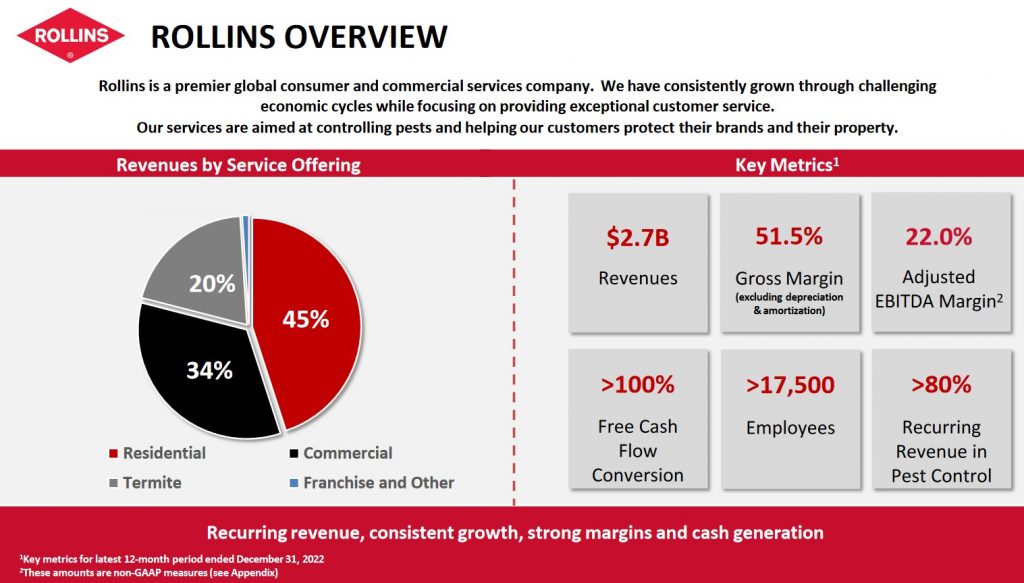
Source: ROL - Q4 2022 Earnings Presentation - February 16, 2022
Investor Control
Investors should be aware that a control group that includes members of ROL’s Board of Directors and management has a majority ownership interest. This group holds directly, or through indirect beneficial ownership, in the aggregate, ~51% of ROL's outstanding common shares as of December 31, 2022.
We can view this as a risk or as safety. With a controlling interest in the company, investment decisions are likely to be made for the long-term benefit of the company. Management does not need to concern itself with external investors who might have a more short-term mindset.
Gary Rollins, Chairman of the Board, is currently #190 on the 2022 Forbes 400 list and #509 on the 2022 Forbes Billionaires list. I strongly suspect Mr. Rollins has every intention of increasing his wealth.
His executive compensation plan, closely aligned with the company's growth and profitability, also benefits minority shareholders.
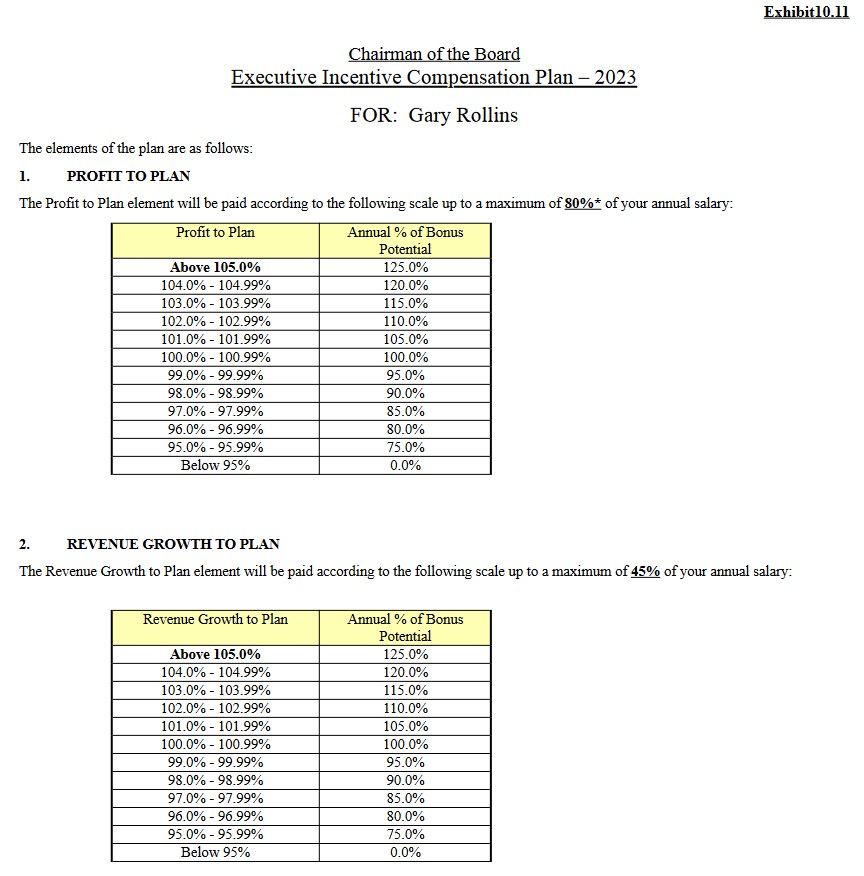
Financials
Q4 and FY2022 Results
In addition to ROL's Form 10-K and Q4 Earnings Presentation for which links are provided above, I reference Form 8-K.
The following is a financial recap of ROL's financial results in Q4 and FY2021 and FY2022.
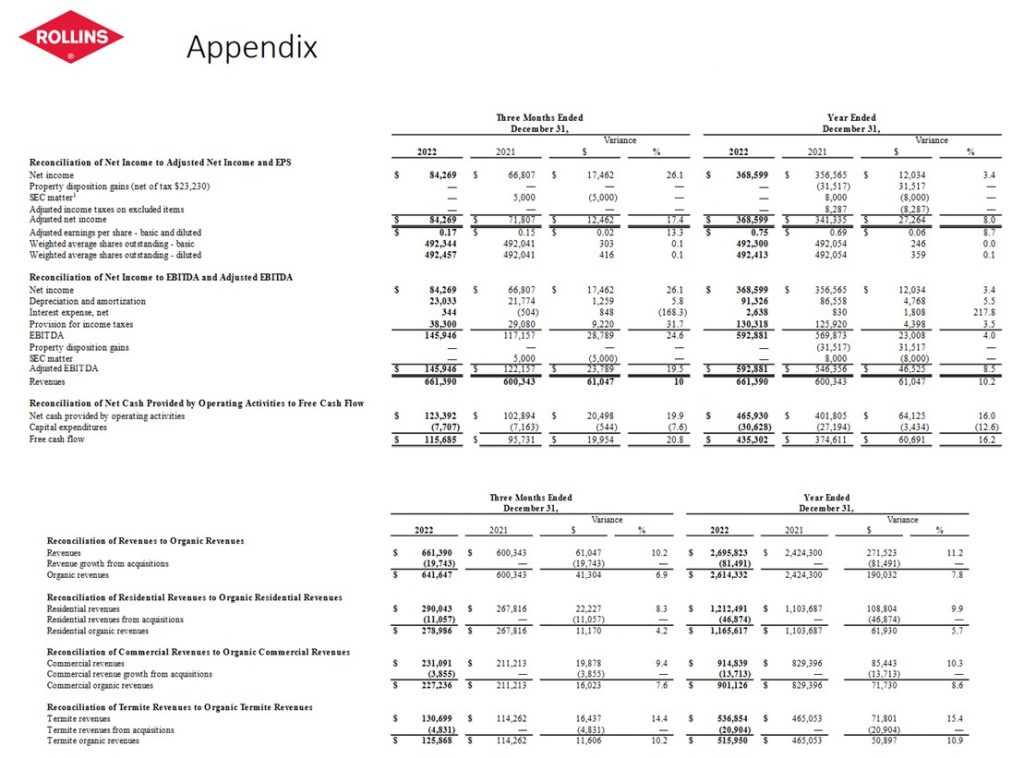
Source: ROL - Q4 2022 Earnings Presentation - February 16, 2022
As noted earlier, acquisitions are a key component of ROL's long-term growth plans. It completed 4 acquisitions in Q4 but has proactively remained on the sidelines during the last few months of 2022 and has turned its attention to deals in its pipeline.
In my previous posts, I reference how ROL remains committed to driving efficiency by leveraging technology.
Building off its successes with routing and scheduling technology at Orkin and Western Pest Services, ROL is rolling out routing and scheduling technology initiatives at Clark and HomeTeam. Clark expects to be at full utilization by the end of Q1 2023 and HomeTeam should complete their implementation and be at full utilization by the end of Q2 2023. Both brands have seen an improvement in their on-time delivery metrics since implementation started.
In addition to improving efficiency and productivity, these initiatives can meaningfully reduce overall mileage between service visits and drive time for technicians. This lowers fuel requirements and has a direct impact on labour costs.
On the Q4 earnings call, management stated that Sales, General and Administrative expenses represent a key focus area. At just under 30% of revenue, ROL feels there are opportunities to drive improvement.
In Q4, ROL generated $0.116B of free cash flow (FCF) on $0.084B of earnings. FCF increased by over 20% in Q4 and ~16% for the entire year.
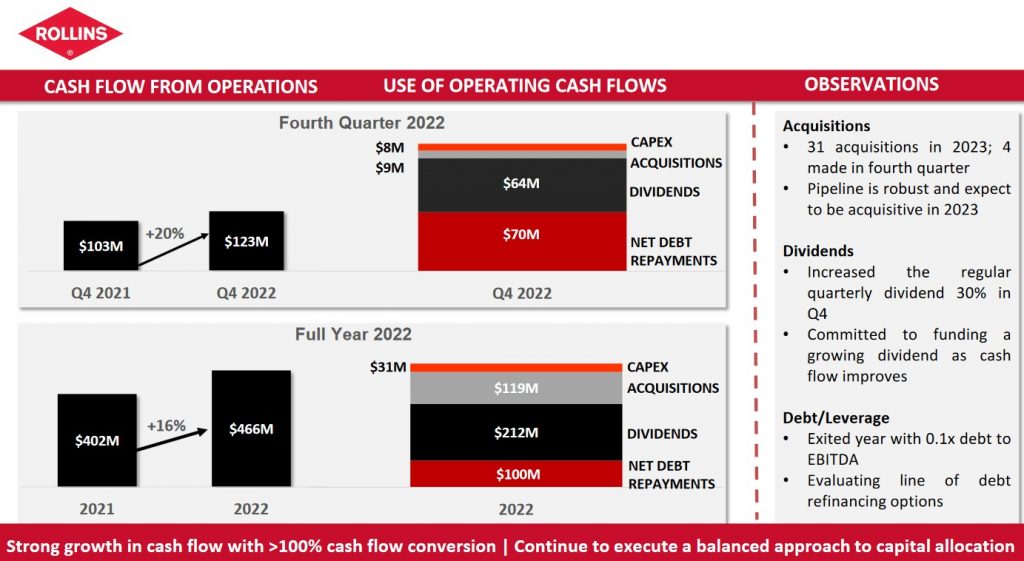
Source: ROL - Q4 2022 Earnings Presentation - February 16, 2022
Unearned Revenue
The current portion of unearned revenue at FYE2018 - 2022 was ~$0.116B, ~$0.123B, ~$0.131B, ~$0.145B and ~$0.158B. This unearned revenue is recognized over the next 12-month period and represents the receipt of customer funds before the rendering of services. Once the services are provided, the liability is reduced and ROL reports the appropriate revenue and related expenses on its Income Statement.
At FYE2021 and FYE2022, ROL had long-term unearned revenue of $23.5 million and $29.9 million, respectively. The majority of unearned long-term revenue is recognized over a period of five years or less with immaterial amounts recognized through 2033.
As noted in prior ROL posts, investors need to account for this when looking at ROL's current ratio (current assets/current liabilities) and quick ratio (current assets minus materials and supplies/current liabilities). If we deduct ~$0.158B of the current portion of unearned revenue from ~$0.494B of total current liabilities on December 31, ROL has ~$0.336B of current liabilities. Its current assets, however, amount to ~$0.349B of which ~$0.2847B is cash and cash equivalents and trade and finance receivables.
Free Cash Flow (FCF)
In FY2011 - FY2022, ROL generated FCF of (in millions of $): 136, 123, 144, 165, 157, 193, 211, 272, 292, 413, 375, and 435.
ROL's FCF conversion typically exceeds 100% and FY2022 is no exception.
FY2023 Guidance
Management does not provide guidance.
Credit Ratings
No rating agency rates ROL's debt.
Details of ROL's lease commitments and debt facilities are in Note 10 in the FY2022 Form 10-K.
As shown in the first image of this post, ROL very conservatively manages its debt. Debt balances are down $0.1B since the beginning of FY2022 and cash is down only $10 million finishing at $95 million at FYE2022.
On the Q4 earnings call, management states it is actively evaluating options to refinance the credit facilities that are set to expire in April of 2024.
Dividend and Dividend Yield
In FY2017 - FY2022, ROL distributed ~$122, ~$152.7, ~$153.8, ~$160.5, $208.7, and $211.6 million of dividends.
ROL's dividend history reflects the declaration of a 'special variable dividend' in November with distribution in early December; ROL has eliminated this 'special variable dividend'. I think we can likely expect more significant annual dividend increases going forward; the last increase was 30% ($0.10 increased to $0.13).
On January 23, 2023, ROL's Board declared its 2nd $0.13/share quarterly cash dividend payable March 10 to stockholders of record at the close of business February 10.
At the time of my last review, shares were trading at $42.46 and the forward dividend yield was ~1.22%.
Shares currently trade at $36.30. I envision 2 more $0.13 quarterly dividends at which time we can likely expect the quarterly dividend to increase to ~$0.16. On this basis, the next 4 quarterly dividend payments should total $0.58 ((2 x $0.13)+(2 x $0.16)) thus giving us a ~1.6% forward dividend yield.
This low dividend yield is likely to dissuade some investors from investing in ROL. Investors, however, should focus on an investment's total potential long-term investment return. The bulk of ROL's future total investment return is likely to continue to be predominantly in the form of capital appreciation.
In 2012, ROL's Board authorized the purchase of up to 5 million shares of the company’s common stock. After adjustments for stock splits, the total authorized shares under the share repurchase plan are 16.9 million shares. It did not repurchase shares on the open market in FY2021 and FY2022. 11.4 million additional shares may be purchased under the share repurchase program.
The number of shares outstanding for the past ~8 years has been relatively stagnant at ~491 - ~492 million shares.
Stock Splits
ROL has had stock splits over the years with the most recent being a 3-for-2 stock split that was announced on October 27, 2020.
Valuation
The high amortization expense related to multiple acquisitions makes it impractical to value ROL using Earnings per Share (EPS). This is because Depreciation and Amortization are significant components of the 'Adjustments to reconcile net income to net cash provided by operating activities' in the Condensed Consolidated Statement of Cash Flows.
Management agrees and in 2021 it started to present the following metrics:
- Earnings before interest, taxes, depreciation and amortization (EBITDA)
- Free Cash Flow
The rationale for presenting these additional metrics is to more properly illustrate ROL's strong ability to generate cash.
ROL uses the simple approach to define free cash flow, which is net cash provided by operating activities less the purchase of equipment and property.
ROL's Net Cash Provided by Operating Activities (OCF) and FCF are:
- FY2018 - ROL generated ~$299 million and ~$272 million in OCF and FCF.
- FY2019 - ROL generated ~$320 million and ~$292 million in OCF and FCF.
- FY2020 - ROL generated ~$436 million and ~$413 million in OCF and FCF.
- FY2021 - ROL generated ~$402 million and ~$375 million in OCF and FCF.
- FY2022 - ROL generated ~$466 million and ~$435 million in OCF and FCF.
When I wrote my November post, ROL had generated OCF and FCF of ~$342.5 million and ~$320 million in the first 3 quarters of FY2022. I projected ROL's FY2022 OCF and FCF to be ~$450 million and ~$420 million. Using these estimates I arrived at a rough approximation of ROL's valuation based on OCF and FCF:
- OCF/share of ~$0.91 ($0.45B/492.4 million shares). Using a $42.46 share price, the valuation based on OCF would be ~46.7.
- FCF/share of ~$0.85 ($0.42B/492.4 million shares). Using a $42.46 share price, the valuation based on FCF is ~50.
ROL ended up generating OCF and FCF of ~$466 million and ~$435 million in FY2022. Using these historical results and the current $36.30 share price, I arrive at a rough approximation of ROL's valuation based on OCF and FCF:
- OCF/share of ~$0.95 ($0.466B/492.4 million shares). Using the $36.30 share price, the valuation based on OCF is ~38.2.
- FCF/share of ~$0.88 ($0.435B/492.4 million shares). Using a $36.30 share price, the valuation based on FCF is ~41.3.
The vast majority of ROL's historical total return has come from capital appreciation and I expect the same going forward. This makes it exceedingly important to acquire shares when they are reasonably valued.
Final Thoughts
As a reasonably risk-averse investor, I like ROL's conservative use of debt. The company is consistently profitable and its ability to generate strong free cash flow gives it the flexibility to appropriately allocate capital to maximize shareholder value.
Management has stated on various occasions that its plan to double in size over the coming decade is achievable. I agree and while I am satisfied with my current exposure of 504 shares in one of the 'Core' accounts within the FFJ Portfolio that slowly grows through the automatic reinvestment of the quarterly dividend income, I think ROL's current valuation presents a buying opportunity.
Although ROL shares are not inexpensive, it is an industry leader that consistently generates improving results. This is a highly fragmented industry that is growing and management has demonstrated its ability to grow organically and through multiple bolt-on acquisitions without burdening the company with a high level of debt.
I anticipate a broad market pullback in 2023 but ROL's share price typically does not experience significant volatility. This is a company that generates ~80% recurring revenue and it has 20+ years of growth. Pests, termites, and wildlife really don't care how an economy is performing. If the conditions are right, they are going to do what comes naturally to them.
I wish you much success on your journey to financial freedom!
Note: Please send any feedback, corrections, or questions to [email protected].
Disclosure: I am long ROL.
Disclaimer: I do not know your circumstances and do not provide individualized advice or recommendations. I encourage you to make investment decisions by conducting your research and due diligence. Consult your financial advisor about your specific situation.
I wrote this article myself and it expresses my own opinions. I do not receive compensation for it and have no business relationship with any company mentioned in this article.


